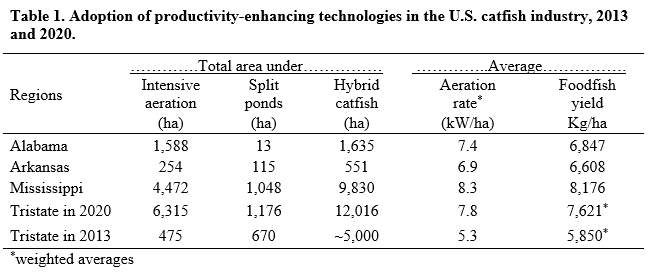ADOPTION OF PRODUCTIVITY-ENHANCING TECHNOLOGIES IN THE U.S. CATFISH INDUSTRY
The U.S. catfish industry has undergone significant technological progress in an attempt to achieve cost efficiencies. Producers have been increasingly adopting improved production practices such as split ponds and intensively aerated ponds in recent years. Subsequently, there has been increased adoption of complementary technologies such as fixed-paddlewheel aeration, automated oxygen monitors (AOM), and hybrid catfish in the foodfish sector. Similarly, fingerling producers are relying on an oral vaccine against Enteric Septicemia of Catfish (ESC). This study monitored the progress of the adoption of alternative and complementary technologies in the US catfish industry. A 2020 multi-state in-person survey in Alabama, Arkansas, and Mississippi (n=68), revealed increased adoption of intensively aerated ponds (6,315 ha) and split ponds (1,176 ha). Adoption of such intensive practices has also led to greater use of complementary production technologies. As a result, the average aeration rate in the tristate region has increased to 7.8 kW/ha with 96% of catfish farms adopting automated oxygen monitors. About 54% of the water surface area in the tristate region was in hybrid catfish production. Eighty-three percent of the fingerling farms and 67% of the fingerling production area were vaccinating against ESC at the time of the survey. The increasing adoption of productivity-enhancing technologies in the US catfish industry explains the recent increases in foodfish yield (43%). Monitoring the progress of adoption of alternative and complementary technologies will guide researchers and Extension personnel involved in the refinement and dissemination of recommendations for these technologies.
